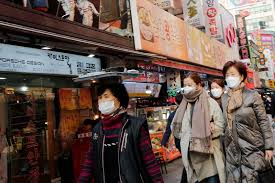Global central bankers scour shopping malls, manufacturers for coronavirus playbook

In the days after a new virus was identified in China on Dec. 31, global central bankers fell back on past experience for a comforting early analysis.
The SARS epidemic in 2003, they noted, had come and gone with little economic impact.
Weeks later, that parallel has failed.
A disease that has sickened around 75,000 in China and ground its economy to a near halt continues to spread outside its epicenter. The latest blow to hopes for a successful containment came Thursday when confirmed cases in South Korea topped 100 and it reported its first death. The streets of that country’s fourth-largest city stood abandoned as residents holed up indoors.
Now, as global finance officials gather in Riyadh, Saudi Arabia, for the latest Group of 20 summit, they will do so having intensified both their level of concern and the breadth of their detective work to understand the economic implications of the outbreak.
That has meant watching measures of coal use and local travel in China for any independent evidence the world’s second largest economy is returning to normal. They are watching disease counts outside China as the best indicator of whether the virus has been contained.
In Japan officials are surveying the empty streets of the Ginza shopping district and tallying airline and cruise ship cancellations, and pondering if an economic rebound they had counted on for later this year will fizzle.
In the United States, Fed officials are quizzing local business contacts and hearing from entrepreneurs blindsided by vulnerabilities in their supply networks.
Businesses “have supply chains that are intimately involved in China sometimes in ways they did not know,” Richmond Federal Reserve Bank President Thomas Barkin said in an interview Wednesday, recalling a conversation with one medical manufacturer that “had a supplier who had a supplier who had a part in China.”
SHORT HIT OR GLOBAL RECESSION?
Given the evolving and unpredictable nature of any viral outbreak, analysts have no tried and true way to model the event.
But policymakers and analysts say this much is clear: the more they talk to people, they more they understand China’s deep role in global supply chains. That means the longer the outbreak remains uncontained, the higher the likelihood that it could become a systemic problem.
Barkin said unknowables include just how flush businesses were with parts inventories before China began quarantines and business closures to stop the spread of the virus or how flexibly companies can move to other suppliers. These are issues not captured in any particular economic model, leaving central bankers globally in a scramble to get a grip on them.
Forecasters have sketched scenarios that cluster around a limited impact, mostly a drop in China’s first-quarter growth. But they also include a possible contraction in the global economy or, in the worst case, a European and U.S. recession as global demand falls.
That’s not the base case at the Fed, the European Central Bank or the Bank of Japan, with no push yet for policy action or rate cuts to offset an unwelcome economic shock. But policymakers acknowledge they are flying somewhat blind.
“My read is if everything gets up to speed in the next few weeks it will be a minor bump that won’t be an issue. If you are out for months then you have a more significant impact on probably 10 to 15 percent of the economy” that depends on Chinese suppliers or exports to the country, Barkin said.
Similar time-dependent assessments are offered in Europe and Japan, where that country’s close economic ties to China have officials particularly wary.
“The picture has changed completely from before the outbreak,” said a BOJ official, who was not authorized to speak publicly about the matter.
RISK OF ‘CONSEQUENTIAL SPILLOVERS’
Economists typically look at events like this with a sanguine eye. They hurt the economy in the moment, but some losses are permanent: While a consumer can still buy that car a month or two later, forgone trips or restaurant meals are not necessarily made up.
But overall, an inevitable bounce back offsets the shock.
Some events, however, prove systemic. Policymakers and analysts point to how a 2011 earthquake and flooding compromised a nuclear reactor in Japan’s Fukushima province, and led global businesses to rethink supply networks to make them less dependent on any single source.
In a paper last year (here), Fed researchers studied what a “hard landing” in China – a combination of financial stress and a sharp drop in gross domestic product – would mean for the U.S. and global economies.
The results weren’t pretty.
The research predicted “consequential spillovers to the United States and global economy through both real trade links and financial channels.” U.S. officials as a rough rule of thumb say a 1 percentage point drop in China’s growth shaves about a 0.2 percentage point from U.S. GDP – noticeable, but not likely to cause a recession unless the shock is massive.
From Europe’s perspective, it is not yet time to worry – but to stay watchful.
“The history of these has been that there could be a significant short-term effect of events like these, but no long-lasting effect,” ECB chief economist Philip Lane said in Berlin. “So this is the baseline. Let’s see – it depends on how quickly it is contained.”
